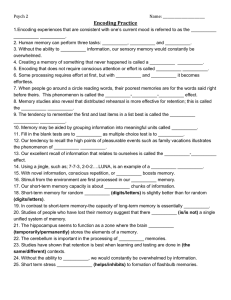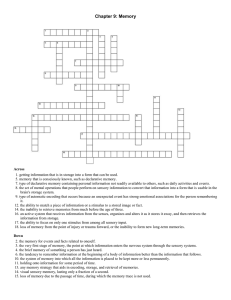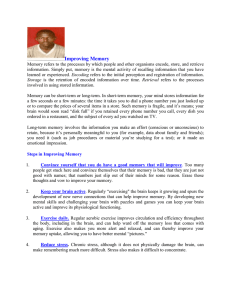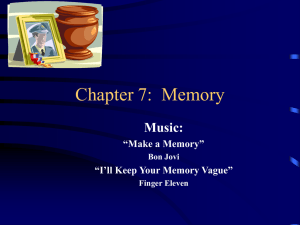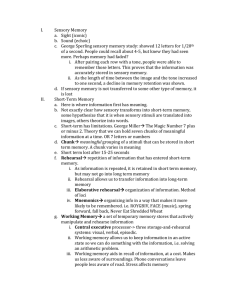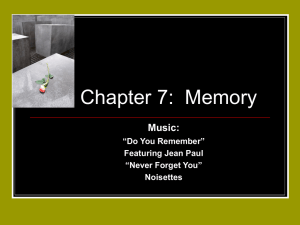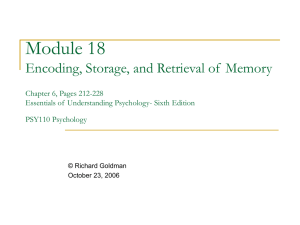Memory
advertisement
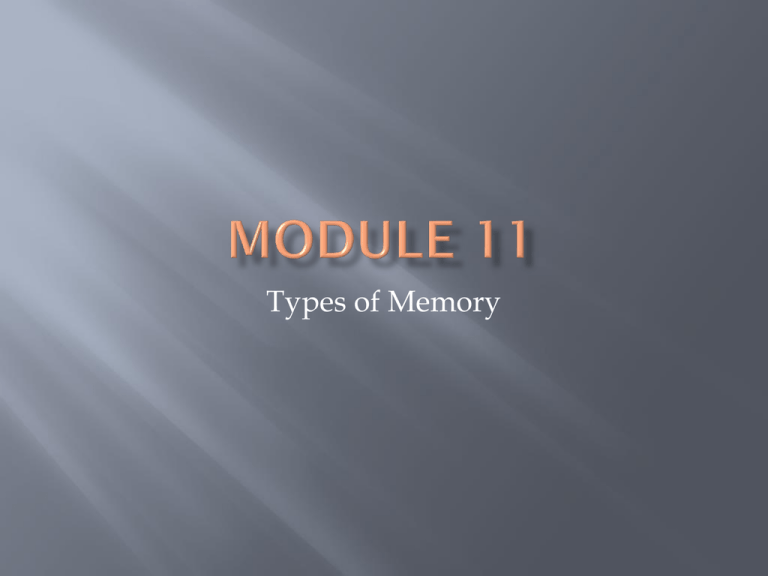
Types of Memory The ability to retain information over time 3 processes: o Encoding o Storing o Retrieving Refers to making “mental representations” of information, so it can be placed in our memories The process of placing encoded information into relatively permanent mental storage for later recall New information stored by making associations with old information is easier to remember The process of getting or recalling information that has been placed into short-term or long-term storage Sensory Memory Short-term Memory Long-term Memory • Initial process that receives and holds environmental information in its raw form for a brief period, no more than several seconds • This process can hold only a limited amount of information – an average of 7 items – for 2 to 30 seconds • Process of storing almost unlimited amounts of information over long periods of time Sensory memory is environmental, and requires attention for it to be remembered. If you pay attention to it, it will move to short-term memory If you pay attention here, it may be transferred to long-term memory, or remembered slightly longer if it is rehearsed Iconic memory automatically holds visual information for about ¼ of a second: as soon as you shift attention the info disappears (“icon” means “image”) This is why we are not “blind” when we blink Echoic memory holds auditory information for 1 or 2 seconds. This allows you to process speech sounds long enough to recognize sequences that represent words Prevents too much sensory info from overwhelming us Gives decision time to decide if something is important Provides stability, playback and recognition, or makes things in our environment appear smooth and continuous Paying attention to information in sensory memory allows it to move to short-term memory Allows us to hold a limited amount of information for up to 30 seconds. This can be lengthened with “maintenance rehearsal” “7” is the magic average number (Miller, +/-2) Postal codes and phone numbers have 7 or fewer digits for this reason “Interference” results when new information enters short-term memory and overwrites or pushes out existing information Chunking can increase short-term memory Active process, using the prefrontal area Attention Rehearsal Storage This allows us to selectively attend to relevant information and disregard the rest. Also, to hold information for a short period of time until we decide what to do with it. Short Term memory Picture puzzle 7 is called the magic number, because it is the average number of things most people will remember. Memory is a process Long-term memory interacts with other memory through attention Encoding to long-term memory occurs when we pay enough attention to something, repeat it or rehearse it, or form an association with it. How easily and accurately information then can be retrieved or recalled depends on many factors. The process of transferring long-term memories back into short-term memory This may be more difficult if the associations formed were weak, or if you formed no new associations with the old information Capacity and permanency is almost unlimited, if drugs and disease do not interfere with memory circuits. Chance of retrieval depends on how the info was encoded and amount of interference from related information. Accuracy can under-go change and distortion, very few memories are as accurate as people think. Every time memories are recalled, they are malleable and can be altered. Bear, giraffe, Wolf fly deer Elk gorilla elephant frog snail Turtle shark ant owl Primacy effect refers to better recall of information presented at the beginning of a task – there is more time for rehersal Recency effect refers to better recall of information at the end of a task – last items remain in short-term memory, or even sensory memory. You were least likely to remember the words in the middle, as they may be unrehearsed and are not encoded Long-term memory: Declarative and Nondeclarative Emotional memories Encoding Processing theory False and repressed memories Cultural memory Unusual memory

